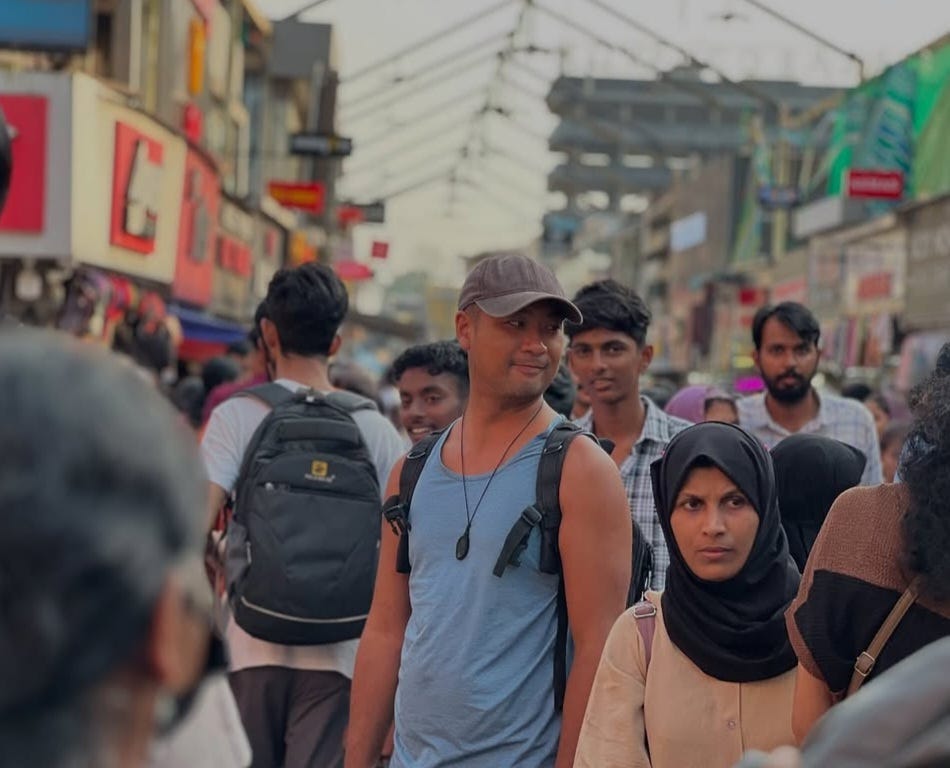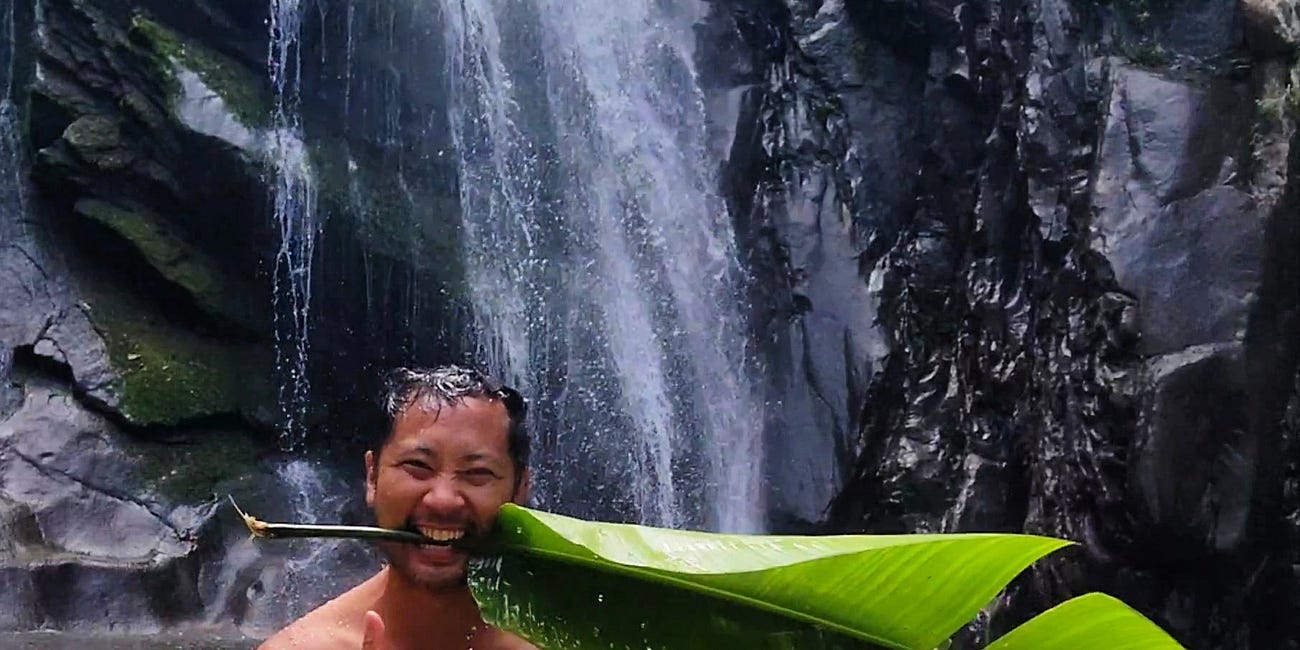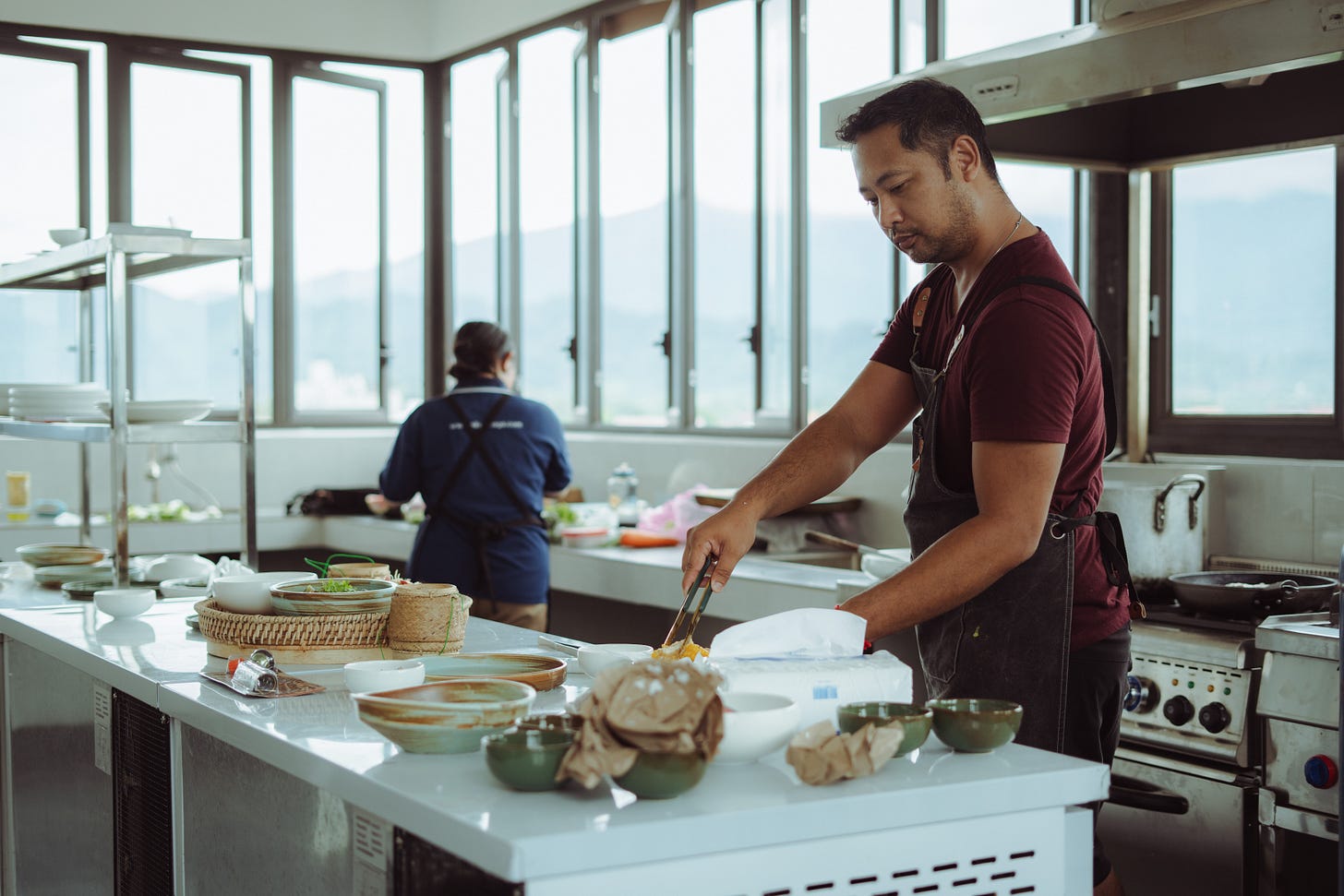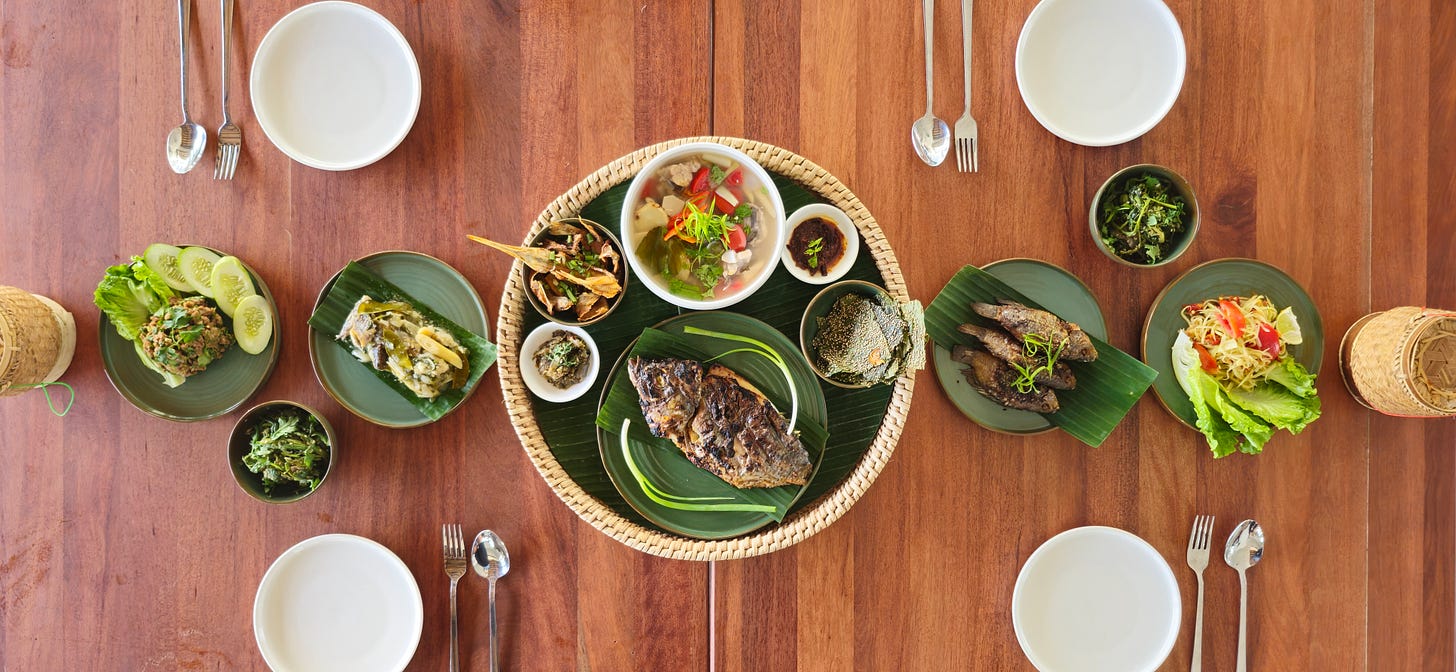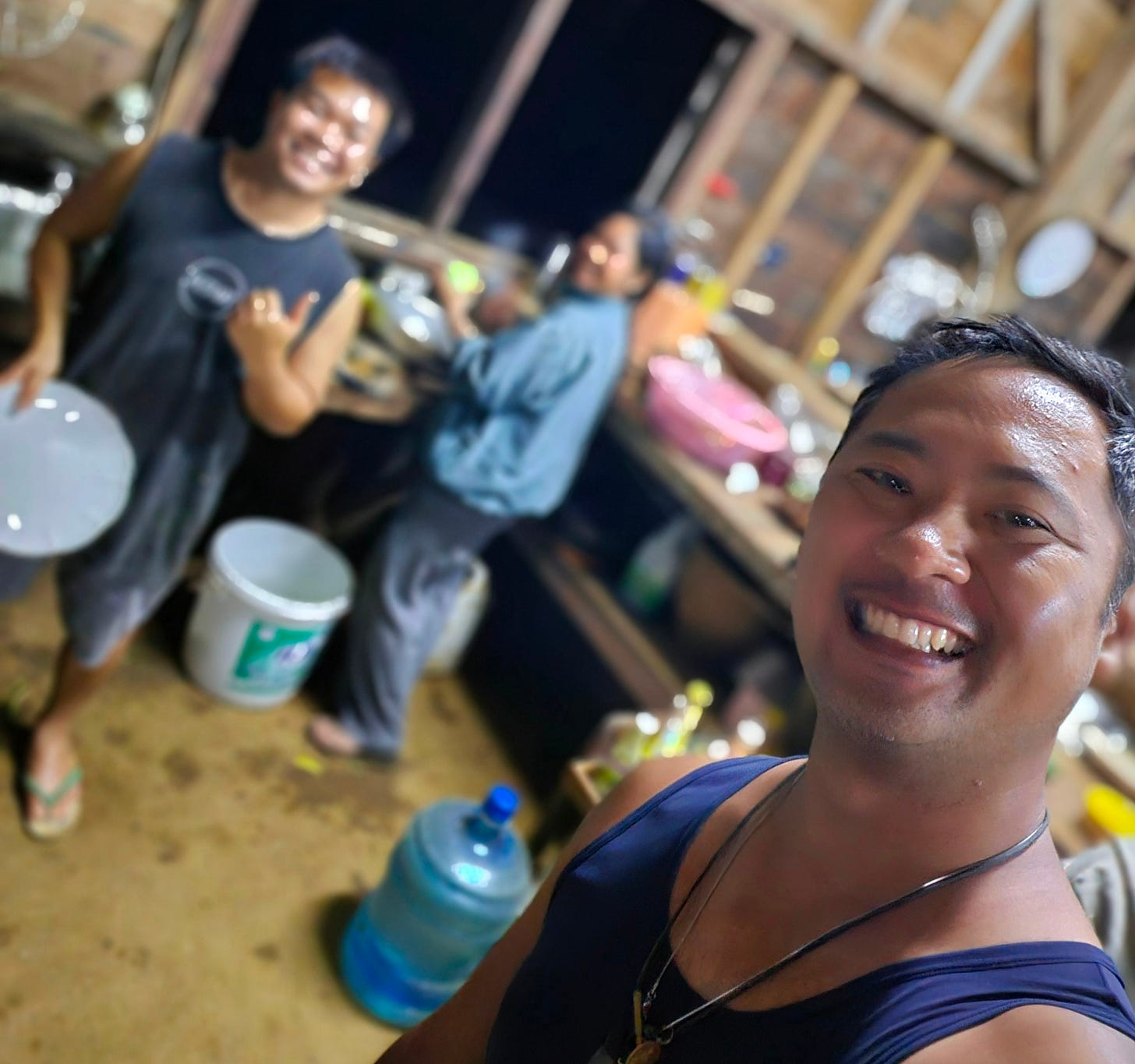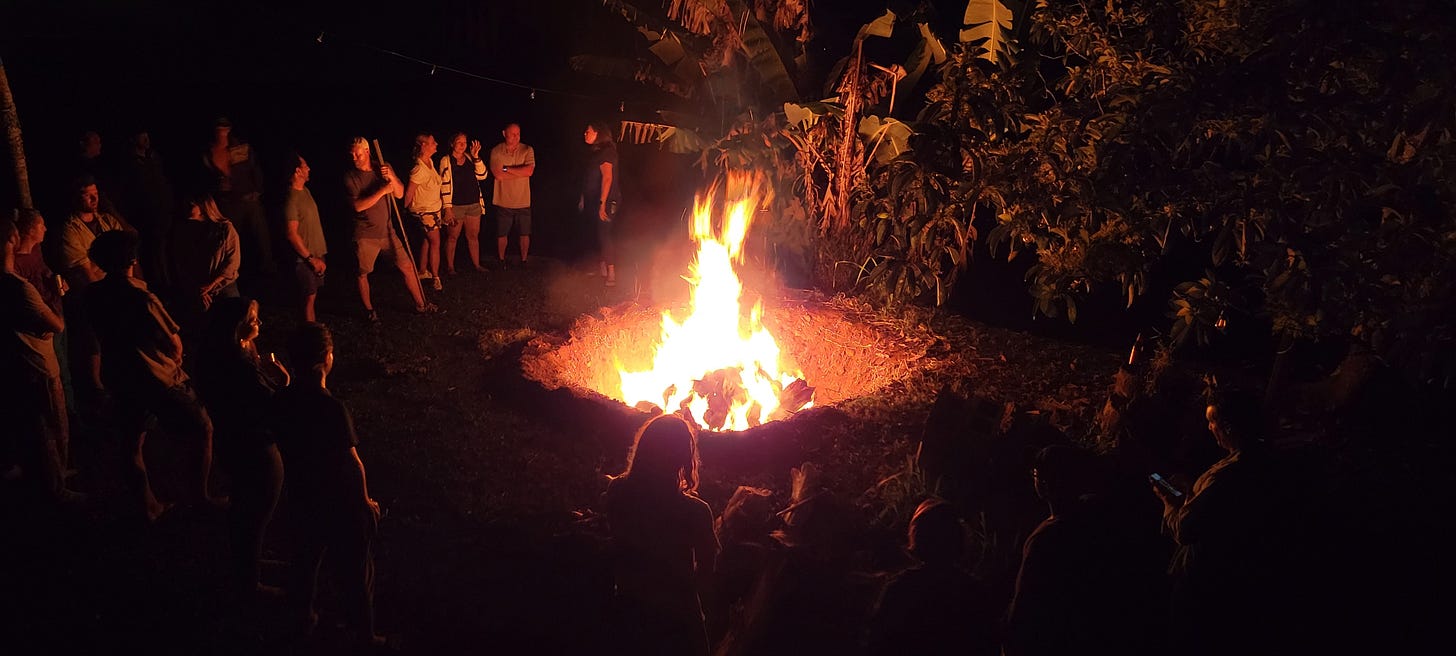SaiTera - The The Worlds First 24hr synchronized, multi-sensory dinner experience around the world, in one day.
Coming 2027...
SaiTera Begins
Everywhere I’ve been, I’ve left a thread of myself. Every person I’ve met, I carry a thread of them. These threads stretch across the world—through blood, through friendship, through a shared meal.
These are the places that shape SaiTera:
…Lowell, Boston, Philadelphia, New York City, New Orleans, Austin, Ann Arbor, Denver, Santa Fe, Fresno, Oakland, San Diego, San Francisco, Fairbanks, Anchorage, Kona, Paia, Honolulu, Kīlauea, Tokyo, Shanghai, Hanoi, Pakse, Luang Prabang, Bangkok, Chiang Mai, Pai, Nepal, Bangalore, Hyderabad, Kerala, Iran, Georgia, Cape Town, Nigeria, Athens, Sardinia, Lyon, London, Birmingham, Dublin, Iceland, Brazil, Argentina, Peru, Antigua, Costa Rica, Puerto Rico, Oaxaca, Mexico City, Puerto Vallarta…and many many more…
…And now, after 4 years of dreaming the thing finally has a name; SaiTera—the world’s first synchronized, multi-sensory journey across 24 time zones. A continuous chain of nourishment, storytelling, and cultural exchange, all happening in one day. 24 chefs, 24 time zones, 24 meals—each one carrying an ingredient forward, passing a story along, creating a living, breathing map of global connection.
I could go on about what this means, the logistics, the impossibility of it all—but if you already feel the pull, check out the website:
SaiTera - A Global Weave of Cultures, Nourishment, and Storytelling
This particular article is if you want to know why this exists, how it all began—read on and consider subscribing if you haven’t already! Thank you, thank you. :)
How Did I Get Here?
Almost five years ago, I set out to see the world—not just as a traveler, but as someone searching for the invisible roads that connect us all. I wasn’t just looking for new places; I was looking for context—who I am, what my food story is in the library of stories from people around the globe. I knew I had to go and see things with my own eyes and exploring the world through youtube was not enough. I wanted to feel it in my DNA.
I crossed the continental United States twice. Then, I went further. Cities, villages, mountain roads, oceans. I wanted to trace the Silk Road, follow ancient trade routes, understand how food moves across borders, how meals mold history.
…But the road is rarely straight.
A chance opportunity whisked me away from Laos and took me to India, where I became the Head Chef of India’s Burning Man. In that chaos, in that energy, I realized something. I already had all the pieces for the BIG ONE. A spark and calling of an idea that seems to have been hidden in me for longer than I can imagine. The biggest hurdle was met, I already knew someone in every timezone on Earth.
The vision was already forming—I just needed to sit still long enough to hear it clearly. I needed to step back. To listen. To ask myself, my closest friends, my mentors—what is this thing, and how do I bring it to life? I felt SaiTera before it was named.
The Realities of the Road
I won’t rehash the details, but after quitting my job in Maui—a move that once felt impossible—I found myself with a little cash and no steady income. I spent the last year living on less than $15,000 traveling, cooking, learning.
It wasn’t easy. I felt insecure. Sometimes, I was afraid to ask for help. But through the kindness of friends, strangers, and a self-published book, I kept going. I am lucky beyond words to have so many people who care.
Still—travel like this is tough without income. I am not a digital nomad. I move through skill-sharing, community, and trust. I knew this past year wasn’t about making money—it was about investing in a bigger vision. I am not against digital work, but I like giving my hands and energy to a cause that benefits the arts, community or food where possible.
After the small success of my first book...(see below)
…I thought, Alright, this is the life I wanted—now how do I sustain it?
This Substack is one of those ways. Between that, hunting for grants, residencies, and occasional freelance work, I’m carving out an ecosystem to support my work going forward. It’s a process. One that’s new to me and sometimes there’s a sense of imposter syndrome as I try to put together something cohesive and meaningful. Asking for money, and determining the worth of words as some kid from the same town as Jack Kerouac, without any formal written training, well it feels like a a very big ask.
It’s going to take time.
And I’m being patient with it. That’s OK I tell myself, this is the year for grant hunting and exploring my options as a creative person. If this were a new job in the traditional sense then I am still getting on-boarded and very much the new guy. I am starting to take my craft seriously but also maintaining a mindset based in how fun it is to tell a story. Besides, I might actually like grant hunting, that was surprising. The idea of telling a story and someone might actually acknowledge that you have something to say is pretty cool.
[See: the following video for Jarritodos National Competition Entry for a video I made that won runner up in in the Food Category! That was a trip.]
Food As Time Travel
I love food. I love sharing it, talking about it, learning about it—and I love how food is edible time travel.
To eat a plate of pasta is to step into history. It’s past lives in the techniques—watching my friends mix flour and eggs into dough, the simmering, the boiling, the peeling of tomatoes for a red sauce. Whose hands are really moving, when the act of kneading dough carries centuries of history in its DNA?
Sometimes, when I cook a Laotian meal and everything is coming together just right, I say:
"I’m cooking with the ancestors now."
For pasta and everything surrounding it, I have a deep love and respect for how it preserves an entire nation's culture. There’s so much tradition and history seeped into any dish that uses pasta—from linguine to ravioli. So much pride. In the best way.
Of course, I have my own food stories—sticky rice, papaya salad, the flavors I grew up with. That history is personal, it's mine. But I want to know the stories in my friends' kitchens.
I felt this most deeply in India, standing barefoot on cool tile, watching mothers move through their kitchens like choreographed dancers.
"How about you come over? My mother wants to make you a real Indian breakfast."
"Really? That’s amazing! Do I bring anything?"
"No, just come eat."
This was a conversation with my new friend Vishnu. I don't want to go too far off track—there’s so much that happened in India, and that story will be told in full another time. But the point is:
A person I had met just weeks before was inviting me into his mother’s kitchen.
I had never been to India before, but I had a feeling I was about to discover an entirely new palette of flavors, textures, colors, sounds, and movements.
Through different kitchens, different families, different stories, I started to see India through food. Each region has its own take on favorites like biryani, dosas, or appam. Every household has its own shade of turmeric when crafting a tikka masala.
And what struck me most—what really stayed with me—was the shared understanding of food. Food here was woven into everything—technique, ingredient, story. It was both deeply personal and universally familiar.
And when I step back and look at India from this perspective, it opens up something incredible—This is what happens when a country celebrates, protects, and honors ritual and tradition over thousands of years.
Indian cuisine is ancient, deeply loved, and respected worldwide—because its families have never let the fire go out. Which begs the question, what did we lose and what recipes will we never see again because of war, genocide, famine, acts of god, colonozation, climate change? I don’t mean to get down on the topic but at the same time it starts to bring up the resilence and strength of a people which is the part I would like to focus on.
A chef cooking pongal, a sort of rice porridge that honors the harvest, for Pongal Festival in a village in southern India. 2024
Let’s Go Back to Pasta for a Minute
This beloved, well-traveled food traces some of its roots back to China’s Silk Road, where tomatoes, wheat, and spices first moved across continents. There’s a lot of history to unpack here, and plenty of food scholars would challenge certain claims—but that’s part of the beauty of food history.
To me, pasta’s story goes even further. It goes back to the first person who boiled water over fire.
The farmer who grew the wheat.
The months it took to plant, harvest, and process that grain before it could become something sitting on a grocery store shelf.
We can go back and ask: Who figured out which minerals and metals to melt, to shape into pots and pans for each dish?
Who first saw fire, stone, water, and raw ingredients—and knew they could transform them into something more?
We live in a world of personal pizza ovens, air fryers, and high-tech induction stoves, but all of it—every step—traces back to someone, somewhere, figuring out the alchemy of food.
Pasta is Time Travel.
Of the past—in its techniques, passed down through hands, through generations.
In the present—commanding the senses, bringing us together over a meal.
For the future—as nourishment, as a carrier of tradition, as something that will always find its way to the table.
Then SaiTera is my ultimate Time Machine.
Nothing Is Made in a Vacuum
Back in art school, I was told: “Nothing ever created was made in a vacuum.”
Art exists perpetually in conversation with the worlds before and after it. Most innovations dont exist without something happening before it.
Without Da Vinci, we don’t get Banksy running wild across the streets of London. Also somone had to make spray paint.
Without Michelangelo, we never get Blender, a 3D rendering software. Also someone had to make computers.
Without Thomas Edison, we never get the internet—and maybe my words are never written, never shared, never sent through satellites and fiber optic cables. Also somone had to go to space to build the networks.
"…man made the electric light, to take us out of the dark…” sings Mr. Brown—through a microphone developed by a lineage of inventors, industrial designers, and engineers.
…And so the engineers, mathematicians, scientists, designers, chemists, artists, chefs, and creators—from Python to prehistoric lithographs—continue to shape the way we live.
Right so why am I saying this? Spongebob?
Because I want to highlight that in the innovations of the culinary arts, or perhaps even before it was called ‘culinary arts’ that— simply, in the history of food we own a great deal to the inventions and innovations of people who either needed to solve a problem. From famines that asked China to and develop rice paddies or those who figured out fermentation to make kimchi. I want to live in a world that is more aware of our collective growth and express gratitude for our forebears.
The Foods That Bind Us
“Under the sky, under the heavens, there is but one family. It just so happens that people are different." Bruce Lee
Our domain is vast—stretching across tundra, jungle, valleys, mountains, and desert suns that never stop burning. We are as much in the deep sea as we are in the night sky. They say kingdoms rise and fall, but if we zoom out—if we view humankind as one entity—then we have built the longest, most intricate, and most impressive empire to ever exist.
As a species, we are capable of immense destruction. But even more than that—we are capable of incredible creation.
I love us. We are flawed, yes, but I don’t believe anything is out of reach when human kindness and ingenuity align. We are layered in ways that stack upon one another, build upon one another—all part of one great kingdom of humankind. I know I’m starting to sound preachy, but let me hammer this one down for a second:
What if we never lived in borders?
What if we actually saw each other as one species, one race, one community?
What we could build—the sheer force of collective creation—would be both immensely terrifying and profoundly beautiful.
We live in a time where we can message across oceans in an instant. Ask for the WiFi password in any language. Trade ideas across time zones before breakfast.
We are more connected than ever. And yet—it still doesn’t hit the same way as salt.
Something as simple as salt has done more to unite our collective palates than any fiber optic cable ever could.
So if our minds are connected through the internet, then our stomachs are connected through the Earth that feeds us.
Right. So, Pasta.
Everything is pasta.
SaiTera is my pasta.
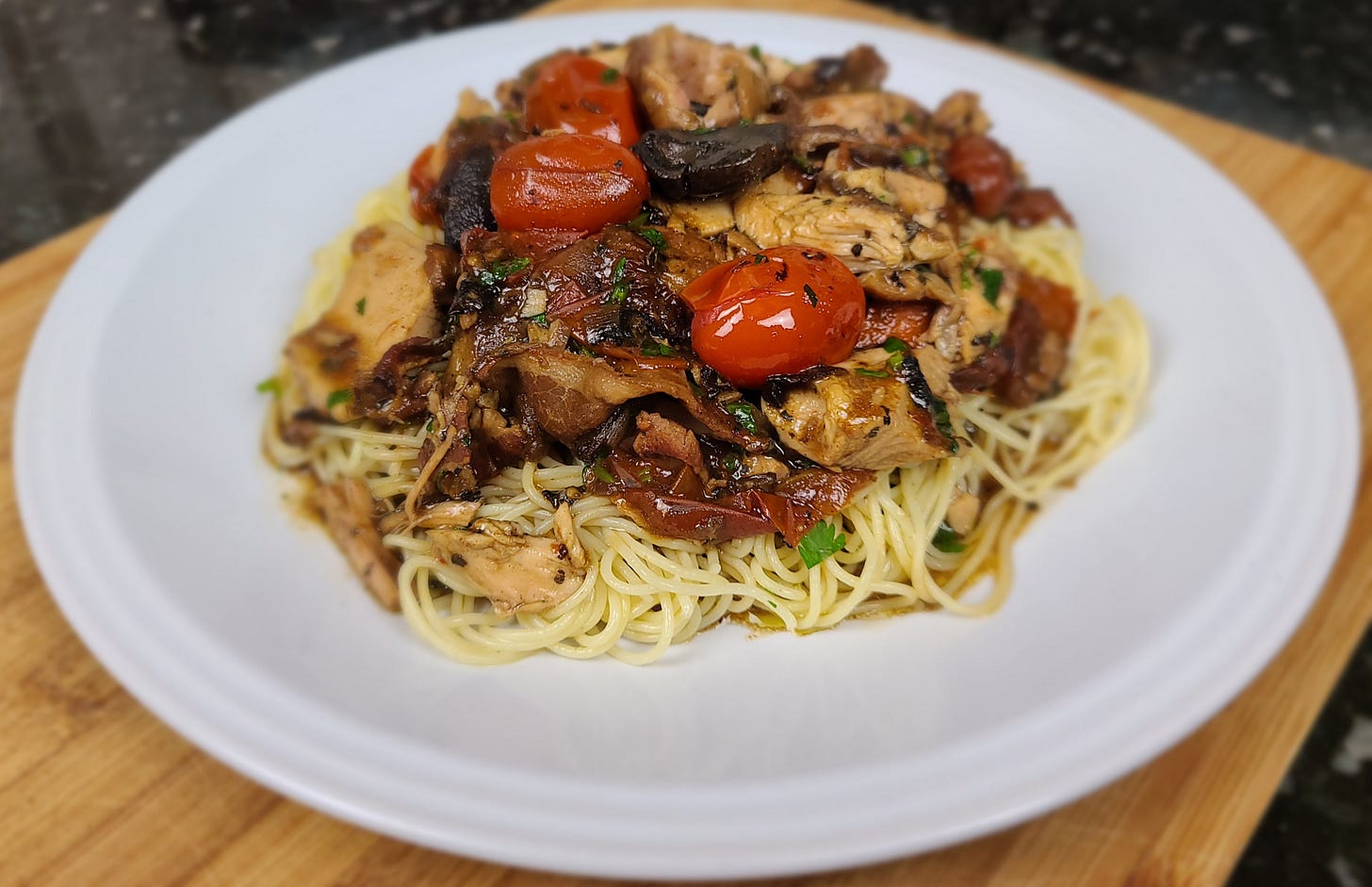
—Who the hell made pots?!
ANYWAYS—food binds us to the past and anchors us in the present.
The scent of garlic hitting hot oil—harvested from a grove tended for generations—pulls you into the moment. Maybe you’re stirring a red sauce, steam rising, thick with umami. Maybe you’re a carbonara person, waiting for the guanciale to crisp just right. Either way, you are here, now. And it’s damn hard to eat without your hands instinctively reaching for that warm, buttery garlic bread.
Each meal brings us one step closer to the future—that plate of pasta, maybe handmade at a friend’s kitchen table, shared in celebration, or just because. The warmth in your belly, the way it carries you forward into the night, lulling you into some kind of cozy food coma.
Isaac Newton was all about those apples, and now we’re launching rockets into space.
We are all part of something when we eat. Every bite connects us—to each other, to memory, to something far greater than ourselves.
Food reminds me that no one is truly alone here.
And maybe—it’s time we take stock of that. As one human race.
Enter SaiTera: A Global Weave of Cultures, Nourishment, and Storytelling
In 2020, I was staring at a map of the world taped to my wall. I had this idea—see the whole world one day. That led me down a rabbit hole of Silk Roads and ancient trade routes, but you’ll have to check out my book to see how that all shakes out.
For now, here’s what I want to show you: I took a Sharpie and wrote $5000 in the bottom-right corner. I was convinced that with that much, I could see the world. And surprisingly? I wasn’t too far off. That number was the first inkling of something bigger.
I used to joke that my retirement meal plan was having a kitchen in every time zone, somewhere in the world where a meal would always be waiting for me. Turns out, it might not be a joke anymore.
The whispers got louder as I traveled. I moved from place to place, meeting, learning, eating every story I could find. And then—it hit.
The voice in my head started saying, louder and louder:
Johnny, what happens if we take this one step further?
What happens if we all cook together—across 24 time zones?
What happens if we can feel the presence of each other's dinner tables, all the way around the world?
What happens when food itself becomes the thread that binds us?
Now That We Found SaiTera, What Are We Going to Do With It?
I will navigate the Silk Road in time, but first, I had to start SaiTera. The website is live. That took a solid month of writing. I’m proud of it.
The next step? Keep the pace. Keep the energy.
Since launching, I’ve been putting in 10-hour writing sessions, nonstop. I love writing, but my wrists are starting to feel it. So far, I’ve submitted this project to six grants and one residency.
I don’t know if SaiTera will get the funding it needs, but even if it doesn’t—I believe in it. I will fund it myself through freelance gigs, through whatever it takes. Nothing is going to stop me.
I know one meal alone won’t solve systemic issues, but this is what I can do. This is my way of combating negativity in the world. Because as far as I’m aware, no big, sustainable shifts in consciousness have ever happened on an empty stomach.
Let’s Cook.
I had to travel—to get the experience, make the connections, and share stories.
I had to write a book—to organize my thoughts and see the shape of this project.
I had to visit my ancestral roots—to learn what it means to honor my own food and traditions.
I had to—though I don’t always want to admit it—work corporate event jobs to grasp the tools needed to coordinate something this big.
I had to return home—to sit, write, organize, and build SaiTera from the ground up.
Everything I have ever done has led to this.
I have all the pieces.
And now—here we are.
SaiTera is happening.
Coordinating across 24 time zones through a mostly grassroots operation is going to take some serious creative thinking.
But I fear nothing.
How could I, when I’ve worked this long to get here?
When the 24 chefs are assembled, when the first meal is shared, when the first story is told—
Who can stop us?
Then…well your going to have to wait and see whats after that.
To See more on how I plan on bringing the worlds first multi-sensory synchronized 24hr dinner to life check out the website here:
SaiTera
SaiTera is being set at the table. If you believe in this vision, if you want to be part of something that connects us through food and story—join in. Subscribe, share, or just stay in the loop. We’ll see you at the table.



